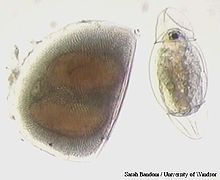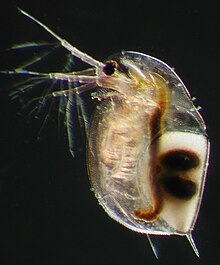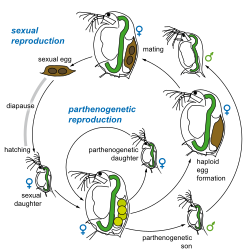43:
56:
429:
82:); they are provided with an extra shell layer, which preserves and protects the resting stages inside from harsh environmental conditions until the more favorable times, such as spring, when the reproductive cycle is able to take place once again. Ephippia are part of the back of a mother carrying them until they are fully developed. After molting, the ephippium stays in the water, or in the soil of dried puddles, small ponds, and
165:
35:
55:
50:
carrying a resting egg (ephippium). The two dark, oval spots on the ephippium mark the places where the two resting eggs are located. The female was collected in a rock pool in south-western
Finland. The animal is about 2 mm
86:. The resting stages are often called eggs, but are in fact embryos with arrested development. Ephippia can rest for many years before the embryo resumes development upon an appropriate hatching stimulus.
42:
331:
295:
227:
662:
63:(water flea). The sexual cycle results in the production of the sexual eggs, the resting stages enclosed by the ephippium.
324:
617:
287:
97:
652:
317:
428:
657:
256:. Bethesda (MD): National Library of Medicine (US), National Center for Biotechnology Information.
170:
120:
291:
223:
127:
105:
418:
279:
525:
502:
408:
398:
388:
251:
74:) are winter or dry-season eggs of the various species of small crustacean in the order
607:
590:
413:
393:
28:
646:
585:
553:
517:
143:
135:
548:
489:
471:
383:
341:
247:
79:
24:
164:
309:
507:
83:
38:
Resting egg pouch (ephippium) and the juvenile daphnid that just hatched from it
20:
602:
580:
575:
570:
445:
437:
403:
365:
214:
160:
34:
629:
624:
612:
565:
543:
535:
497:
479:
458:
375:
359:
75:
27:. For Saddlecloth or pad (because ancient Greeks called it Ephippium), see
595:
558:
113:
19:"Ephippium" redirects here. For the largest genus in the orchid family
451:
353:
59:
Schematic representation of cyclic parthenogenesis in the cladoceran
153:
41:
33:
263:
Daphnia: development of a model organism in ecology and evolution
313:
222:. Bethesda, MD: National Center for Biotechnology Information.
253:
Ecology, epidemiology and evolution of parasitism in
Daphnia
54:
216:
Ecology, Epidemiology, and
Evolution of Parasitism in
534:
516:
488:
470:
436:
374:
325:
8:
332:
318:
310:
265:. Oldendorf/Luhe: Internat. Ecology Inst.
183:
209:Dieter Ebert (2005). "Introduction to
7:
189:
187:
14:
427:
163:
272:The physiology of the Cladocera
196:The physiology of the Cladocera
1:
274:. Academic Press, Amsterdam.
198:. Amsterdam: Academic Press.
679:
18:
425:
348:
288:Oxford University Press
270:Smirnov, N. N. (2014).
98:Bythotrephes longimanus
16:Eggs of small crustacea
663:Freshwater crustaceans
64:
52:
39:
58:
45:
37:
261:Lampert, W. (2011).
194:N.N.Smirnov (2014).
147:(small, most common)
340:Families of class
171:Crustaceans portal
131:(invasive species)
121:Daphnia longispina
109:(invasive species)
101:(invasive species)
65:
53:
48:Daphnia longispina
40:
640:
639:
409:Streptocephalidae
297:978-0-19-503742-5
229:978-1-932811-06-3
128:Daphnia lumholtzi
106:Cercopagis pengoi
670:
431:
419:Thamnocephalidae
334:
327:
320:
311:
301:
280:Frederick Schram
275:
266:
257:
234:
233:
206:
200:
199:
191:
173:
168:
167:
678:
677:
673:
672:
671:
669:
668:
667:
643:
642:
641:
636:
554:Pseudopenilidae
530:
526:Cyclestheriidae
512:
503:Leptestheriidae
484:
466:
432:
423:
399:Chirocephalidae
389:Branchinectidae
370:
344:
338:
308:
298:
278:
269:
260:
246:
243:
241:Further reading
238:
237:
230:
208:
207:
203:
193:
192:
185:
180:
169:
162:
139:(large species)
93:
87:
32:
17:
12:
11:
5:
676:
674:
666:
665:
660:
655:
645:
644:
638:
637:
635:
634:
633:
632:
622:
621:
620:
615:
610:
608:Cercopagididae
600:
599:
598:
593:
591:Macrotrichidae
588:
583:
578:
573:
563:
562:
561:
556:
551:
540:
538:
532:
531:
529:
528:
522:
520:
514:
513:
511:
510:
505:
500:
494:
492:
486:
485:
483:
482:
476:
474:
468:
467:
465:
464:
463:
462:
455:
442:
440:
434:
433:
426:
424:
422:
421:
416:
414:Tanymastigidae
411:
406:
401:
396:
394:Branchipodidae
391:
386:
380:
378:
372:
371:
369:
368:
362:
356:
349:
346:
345:
339:
337:
336:
329:
322:
314:
307:
306:External links
304:
303:
302:
296:
276:
267:
258:
242:
239:
236:
235:
228:
201:
182:
181:
179:
176:
175:
174:
159:
158:
150:
149:
148:
140:
132:
124:
110:
102:
92:
89:
29:Saddle blanket
15:
13:
10:
9:
6:
4:
3:
2:
675:
664:
661:
659:
656:
654:
651:
650:
648:
631:
628:
627:
626:
623:
619:
616:
614:
611:
609:
606:
605:
604:
601:
597:
594:
592:
589:
587:
586:Ilyocryptidae
584:
582:
579:
577:
574:
572:
569:
568:
567:
564:
560:
557:
555:
552:
550:
547:
546:
545:
542:
541:
539:
537:
533:
527:
524:
523:
521:
519:
518:Cyclestherida
515:
509:
506:
504:
501:
499:
496:
495:
493:
491:
487:
481:
478:
477:
475:
473:
469:
461:
460:
456:
454:
453:
449:
448:
447:
444:
443:
441:
439:
435:
430:
420:
417:
415:
412:
410:
407:
405:
404:Parartemiidae
402:
400:
397:
395:
392:
390:
387:
385:
382:
381:
379:
377:
373:
367:
363:
361:
357:
355:
351:
350:
347:
343:
335:
330:
328:
323:
321:
316:
315:
312:
305:
299:
293:
289:
285:
281:
277:
273:
268:
264:
259:
255:
254:
249:
245:
244:
240:
231:
225:
221:
220:
217:
212:
205:
202:
197:
190:
188:
184:
177:
172:
166:
161:
156:
155:
151:
146:
145:
144:Daphnia pulex
141:
138:
137:
136:Daphnia magna
133:
130:
129:
125:
123:
122:
118:
117:
116:
115:
111:
108:
107:
103:
100:
99:
95:
94:
90:
88:
85:
81:
77:
73:
69:
62:
57:
49:
44:
36:
30:
26:
22:
653:Branchiopoda
630:Leptodoridae
618:Polyphemidae
549:Holopediidae
490:Spinicaudata
472:Laevicaudata
457:
450:
342:Branchiopoda
283:
271:
262:
252:
219:
215:
210:
204:
195:
152:
142:
134:
126:
119:
112:
104:
96:
84:vernal pools
80:Branchiopoda
78:(within the
71:
67:
66:
60:
47:
25:Bulbophyllum
658:Fishkeeping
508:Limnadiidae
70:(singular:
21:Orchidaceae
647:Categories
603:Onychopoda
581:Daphniidae
576:Chydoridae
571:Bosminidae
446:Triopsidae
438:Notostraca
384:Artemiidae
364:Subphylum
360:Arthropoda
213:biology".
178:References
157:(smallest)
625:Haplopoda
613:Podonidae
566:Anomopoda
544:Ctenopoda
536:Cladocera
498:Cyzicidae
480:Lynceidae
459:Lepidurus
376:Anostraca
366:Crustacea
284:Crustacea
248:Ebert, D.
76:Cladocera
72:ephippium
596:Moinidae
354:Animalia
352:Kingdom
282:(1986).
250:(2005).
91:See also
68:Ephippia
559:Sididae
358:Phylum
218:Daphnia
211:Daphnia
114:Daphnia
61:Daphnia
46:Female
452:Triops
294:
226:
23:, see
154:Moina
51:long.
292:ISBN
224:ISBN
649::
290:.
286:.
186:^
333:e
326:t
319:v
300:.
232:.
31:.
Text is available under the Creative Commons Attribution-ShareAlike License. Additional terms may apply.


